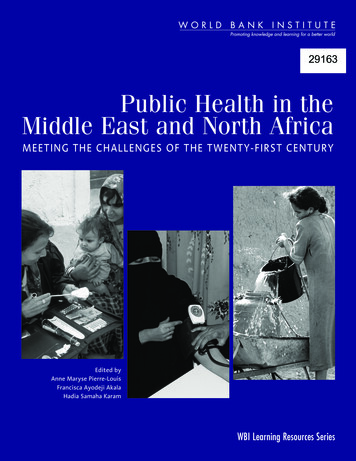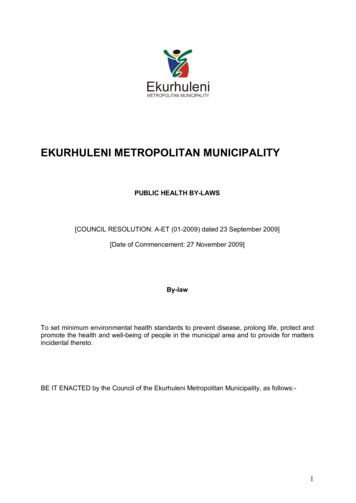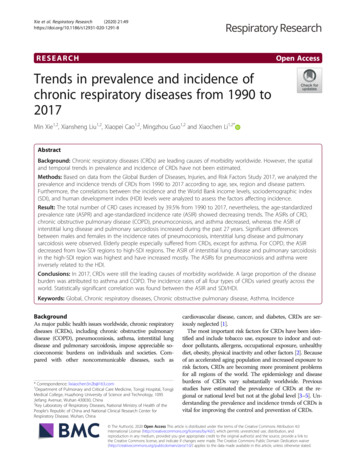
Transcription
29163Public Health in theMiddle East and North AfricaMEETING THE CHALLENGES OF THE TWENTY-FIRST CENTURYEdited byAnne Maryse Pierre-LouisFrancisca Ayodeji AkalaHadia Samaha KaramWBI Learning Resources Series
WBI Learning Resources SeriesPublic Health in theMiddle East and North AfricaMeeting the Challenges of the Twenty-first CenturyEdited byAnne Maryse Pierre-LouisFrancisca Ayodeji AkalaHadia Samaha KaramThe World BankWashington, D.C.
2004 The International Bank for Reconstruction and Development / The World Bank1818 H Street, NWWashington, DC 20433All rights reserved.1 2 3 4 05 04 03 02The findings, interpretations, and conclusions expressed here are those of the author(s) and do not necessarilyreflect the views of the Board of Executive Directors of the World Bank or the governments they represent.The World Bank cannot guarantee the accuracy of the data included in this work. The boundaries, colors,denominations, and other information shown on any map in this work do not imply on the part of the World Bankany judgment of the legal status of any territory or the endorsement or acceptance of such boundaries.Rights and PermissionsThe material in this work is copyrighted. No part of this work may be reproduced or transmitted in any form or byany means, electronic or mechanical, including photocopying, recording, or inclusion in any information storage andretrieval system, without the prior written permission of the World Bank. The World Bank encourages disseminationof its work and will normally grant permission promptly.For permission to photocopy or reprint, please send a request with complete information to the CopyrightClearance Center, Inc., 222 Rosewood Drive, Danvers, MA 01923, USA, telephone 978-750-8400, fax 978-750-4470,www.copyright.com.All other queries on rights and licenses, including subsidiary rights, should be addressed to the Office of thePublisher, World Bank, 1818 H Street NW, Washington, DC 20433, USA, fax 202-522-2422, e-mailpubrights@worldbank.org.ISBN 0-8213-5790-5e-ISBN 0-8213-5791-3Library of Congress Cataloging-in-Publication Data has been applied for.
ContentsForewordvAcknowledgmentsviiAcronyms and Abbreviationsix1 Overview1Nisrine Salhab and Juliana Yartey252 Public Health Functions and Infrastructures in the MENA/EM RegionSalman Rawaf3 The Economics of Choosing and Financing Public Health ServicesPhilip Musgrove4 Public Health “Best Buys” in the MENA/EM RegionMariam Claeson41555 Health Promotion: Key Public Health Strategy for the MENA/EM RegionIlona Kickbusch6 The HIV/AIDS Situation in the MENA/EM RegionCarol Jenkins and David Robalino81977 Addressing the Challenge of Road SafetyAndrew Downing8 Strengthening Primary Health Care in the Islamic Republic of IranBijan Sadrizadehiii11567
ForewordIn September 2000, leaders of the international community embraced eight Millennium Development Goals as the basis for a new global development agenda at the turn of the twenty-firstcentury. Three of the goals reflect the importance of health for sustainable human development,calling for actions to reduce child mortality, improve maternal health, and combat HIV/AIDS,malaria, and other diseases.These health issues are of vital importance in the broad region comprising the Middle East,North Africa, and the Eastern Mediterranean (MENA/EM). But they are by no means the onlyones. An ongoing epidemiological transition in the region is changing patterns of mortality andmorbidity, so that chronic and noncommunicable diseases and injuries now account for a growing share of the overall burden of ill health. These emerging health problems must be dealt with,even as the region’s countries strive to complete the unfinished agenda of protecting mothers andchildren and fighting communicable diseases.This dual health challenge was the central theme of a regional conference held in Beirut, Lebanon, from June 16 to 21, 2002, entitled “Meeting the Public Health Challenges of the 21st Centuryin the MENA/EM Region.” The first of its kind in the region, the conference was organized bythe World Bank and the World Health Organization (through its Geneva headquarters and Eastern Mediterranean Regional Office), in collaboration with the U.S. Centers for Disease Controland Prevention, the National Institutes of Health, the World Bank Institute, and the AmericanUniversity of Beirut. It was attended by 119 delegates and organizational representatives from 22countries of the region: Afghanistan, Algeria, Arab Republic of Egypt, Bahrain, Cyprus, Djibouti,Iraq, Islamic Republic of Iran, Jordan, Kuwait, Lebanon, Malta, Morocco, Oman, Pakistan, SaudiArabia, Somalia, Sudan, Syrian Arab Republic, Tunisia, United Arab Emirates, and Republic ofYemen. Representatives of international organizations such as the European Union, GTZ, FordFoundation, and Saudi Fund for Development also participated.Conferees discussed intersectoral strategies to enhance disease prevention and health promotion in areas ranging from HIV/AIDS to maternal and child health to road safety. Emphasis wasplaced on strengthening public health functions and infrastructures as part of health sector reform programs underway in many countries of the region. Case studies, lessons learned, andexperiences from various countries were presented to encourage cross-fertilization of ideas andknowledge transfer. Those attending included national ministers of health, planning, and finance,who considered ways to engage their ministries and others in intersectoral action on public health.The involvement of multiple entities in organizing the conference was also an attempt to improvecooperation and coordination among international development agencies in responding to thepublic health needs of the MENA/EM region.Seven of the papers presented at the Beirut conference, highlighting some of the key issuesdiscussed, have been edited for inclusion in this volume. They are preceded by an overviewdrawing on a broader range of presentations at the conference. By disseminating the conferencev
viForewordproceedings, the World Bank and its partners aim to help build the knowledge base necessary forthe development of sustainable policies and programs addressing public health issues in theMENA/EM region—an effort that the Bank and its development partners stand ready to assist.The gathering in Beirut planted the seeds for renewed and constructive dialogue. It is our hopethat this book will continue that exchange and stimulate stronger action to address the urgentpublic health challenges of the region.Frannie A. LéautierVice PresidentWorld Bank Institute
AcknowledgmentsThe editors wish to thank the following agencies for their enthusiastic collaboration in organization of the June 2002 conference in Beirut on which this book is based: the World Health Organization, Eastern Mediterranean Regional Office and Geneva headquarters; the Joint United Nations Programme on HIV/AIDS; the National Institutes of Health and the U.S. Centers for DiseaseControl and Prevention, of the U.S. Department of Health and Human Services; the AmericanUniversity of Beirut; and the Ministry of Health of Lebanon. The assistance and support of thegovernment of the Netherlands is gratefully acknowledged. Our appreciation also goes to theWorld Bank’s Middle East and North Africa Region, especially Jean-Louis Sarbib, Regional vicepresident, and Jacques Baudouy, sector director, and to the World Bank Institute, Human Development Unit, for their support and assistance in producing this book.The following experts and speakers contributed to the success of the conference: Ala’ DinAlwan, Hoda Atta, Fatimah Al Awa, Abdel Aziz Saleh, Rafael Bengoa, Mariam Claeson, Joy deBeyer, Andrew Downing, Taky Gaafar, Hussein E. Gezairy, Ghada Hafez, Zuhaier Hallaj, WadihHanna, Carol Jenkins, Ilona Kickbusch, Jaouad Mahjour, Philip Musgrove, Peter Piot, SalmanRawaf, David Robalino, Belgazem Sabir, Bijan Sadrizadeh, Sameh El Saharty, George Schieber,Akihiro Seita, Oussama Tawil, Jihane Tawilah, Ed Wagner, Douglas Weed, Derek Yach, DebreworkZewdie, and Huda Zurayk. We also thank the peer reviewers of all the presentations and theconference proceedings for their professional support. Valuable assistance in the preparation anddelivery of the conference was provided by Julia Blau, Marie-Lily Delion, Henriette Folquet,Peggy Hanna, Karen Kazandjian, Mona Khouri, Sonia Miskjan, Hoda Omera, Sima Ramadan,Nisrine Salhab, Andrew Stewart, and Juliana Yartey. Ultimately, however, our deepest gratitudegoes to the participants at the conference, who grappled with complex public health issues, contributed to lively debate, and suggested ways to improve health outcomes in the MENA/EMregion. This publication is the result of their efforts.Anne Maryse Pierre-LouisFrancisca Ayodeji AkalaHadia Samaha Karamvii
Acronyms and AbbreviationsAIDSAcquired immune deficiency syndromeARTAntiretroviral therapyBCGTuberculosis vaccineCDCU.S. Centers for Disease Control and PreventionDALYDisability-adjusted life yearDOTSDirectly observed treatment, short-course (for tuberculosis)DPTDiptheria, pertussis, and tetanus vaccineEMEastern MediterraneanEPIExpanded Program on ImmunizationFSWFemale sex workerGCCGulf Cooperation CouncilGDPGross domestic productGNPGross national productGRSPGlobal Road Safety PartnershipGTZGerman Technical Cooperation AgencyHepBHepatitis B vaccineHIVHuman immunodeficiency virusHibHemophilus influenzae type BICDInternational Classification of DiseasesIDUInjecting drug userIMCIIntegrated management of childhood illnessIMRInfant mortality ratekphKilometers per hourKSIKilled or seriously injuredMDGsMillennium Development GoalsMENAMiddle East and North AfricaMENA/EMMiddle East and North Africa/Eastern MediterraneanMMRMaternal mortality rateMSMMen who have sex with menMTCTMother-to-child transmissionix
xAcronyms and AbbreviationsNAPNational AIDS programNCDNoncommunicable diseaseNGONongovernmental organizationNIHNational Institutes of HealthOPVOral polio vaccinePHCPrimary health careSTDSexually transmitted diseaseSWAPSector-wide approachTBTuberculosisU5MRUnder-5 mortality rateUNAIDSJoint United Nations Programme on HIV/AIDSUNICEFUnited Nations Children’s FundVCTVoluntary counseling and testingWHOWorld Health OrganizationWHO/EMROWorld Health Organization, Eastern Mediterranean Regional Office
1OverviewNisrine Salhab and Juliana YarteyIn June 2002, government officials and health experts from across the Middle East, North Africa,and the Eastern Mediterranean (MENA/EM) gathered in Beirut for a broad look at public healthissues in the region and strategies for coping with them. There was a sense of urgency to theirtask. Rapid urbanization and changing lifestyles in the region have resulted in a dual burden ofdisease: noncommunicable diseases and injuries are increasing, while infectious diseases remainhigh in most countries. These emerging public health trends demand different and stronger public health systems. However, epidemiological shifts are currently outpacing the rate at whichhealth systems are adapting. Migration, political instability, rising unemployment, and low economic growth—concerns common to all the region’s countries—impact the health of populationsand undermine efforts to strengthen public health systems.Improving public health in the region requires both national and regional action. Globalization has increased inequality among and within countries, and it has helped to spread healthproblems across national borders and across social and economic lines. Moreover, failure of thehealth system in one country affects the health systems of neighboring countries. Opening theconference, Jean-Louis Sarbib, vice president for the Middle East and North Africa Region atthe World Bank, emphasized that effective regional action will depend on transfer of knowledge,exchange of information, political will, and commitment. Such action must happen without delay. Failure to address current public health challenges in a timely and cost-effective manner willlead to high costs for health systems.This chapter briefly reviews the principal issues examined at the June 2002 conference inBeirut, drawing on the presentations of conference participants and on other relevant research. Itconcludes by touching on some of the next steps being undertaken or planned with the assistanceof the World Bank, the World Health Organization, and other international partners.A Diverse and Changing RegionThe MENA/EM region is heterogeneous in terms of both culture and socioeconomic development. The region encompasses the oil-rich states of the Gulf Cooperation Council—among thewealthiest countries in the world—alongside struggling countries that rank among the world’spoorest. Per capita income ranges from 350 in the Republic of Yemen to more than 14,623 inKuwait.1 Countries of the region can be broadly grouped in three categories: Low-income: for example, Djibouti and Republic of Yemen Lower-middle-income: for example, Algeria, Arab Republic of Egypt, Islamic Republic ofIran, Iraq, Jordan, Lebanon, Morocco, Syrian Arab Republic, Tunisia, West Bank/Gaza Upper-middle-income/high-income: for example, Bahrain, Kuwait, Oman, Saudi Arabia,United Arab Emirates.Nisrine Salhab, a freelance journalist in Lebanon, and Dr. Juliana Yartey, a public health specialist, areconsultants to the World Bank.1. All dollar amounts in this book are current U.S. dollars unless otherwise noted.1
2Public Health in the Middle East and North AfricaIt is important to note, however, that the wealthier countries of the region do not necessarilyhave healthier populations or better health services delivery than the less-affluent ones. Nor arethey necessarily in the advanced (fourth) stage of the epidemiological transition. While incomematters, most of the progress in health is due not to higher incomes but to specific actions taken toimprove the public health situation.For example, Oman, an upper-middle-income country, has a strong health system, but itslevels of child malnutrition, low birthweight, and maternal anemia are comparable to the levelsfound in Egypt or Morocco, both lower-middle-income countries. The situation in Oman illustrates the fact that improving health outcomes cannot be achieved through economic growthalone, but depends on increased access to and use of effective preventive and curative services.Although Oman and Saudi Arabia are considered upper-middle- to high-income countries, theyhave not yet reached the fourth stage of the demographic transition, unlike the other countries ofthat income group. In both Oman and Saudi Arabia, birth rates are still very high even thoughmortality rates are low.Demographic and epidemiological transitionsIn general, countries in the MENA/EM region are going through transitions characterized byreductions in fertility and mortality, declining incidence of communicable diseases, and increasesin chronic diseases and injuries. Despite recent fertility declines in certain countries, however,fertility rates in the region are still generally high (see figure 1.1), and population growth ratesvary from 1.1 percent per year in Kuwait to 4.4 percent in Jordan. Because of population momentum, many countries will likely continue to have relatively high population growth rates over thenext 20 years. It is estimated that by 2015, the number of adults in the region will increase by 140percent. This represents the highest adult population growth in the world after Sub-Saharan Africa(World Bank 2002).Figure 1.1 Fertility Rates in the MENA/EM nited Arab boutiSaudi ArabiaWest Bank/GazaYemen01234Total fertility rate (births per woman)Source: World Bank, World Development Indicators 2000.567
Overview3At present, countries in the region have reached different stages of demographic transition,and can be divided into four groups. The first group consists of countries such as Afghanistan,Djibouti, Pakistan, Somalia, Sudan, and Republic of Yemen that are in the early transition stage,with high birth and death rates. The second group is countries in mid-transition, with decliningdeath rates but continuing high birth rates, including Egypt, Islamic Republic of Iran, Iraq, andMorocco. Countries in the third group are well advanced in the transition, with declining birth anddeath rates: they include Jordan, Lebanon, Oman, Saudi Arabia, Syria, and Tunisia. In the fourthgroup of countries, the transition is considered essentially completed, with low birth and deathrates: countries in this group are Bahrain, Cyprus, Kuwait, Qatar, and United Arab Emirates.Hence, all stages of the demographic transition are represented in the MENA/EM region, reflecting the diverse sociocultural and economic circumstances.Notwithstanding these variations, across the region increasing life expectancy and reductionsin fertility are spurring concern about the specific health services needs of an aging population.Problems associated with these trends are becoming evident in some of the high-income Gulfstates. In general, demand for health services is increasing, in terms of both quantity (due topopulation growth in almost all countries), and quality (due to the increasing health knowledgeof the population). Moreover, the changing age structure of the population is resulting in a highincidence of chronic degenerative diseases associated with aging. Advances in medical care meanthat chronically ill patients are living longer with these diseases, resulting in mounting demandfor costly long-term care.In addition to demographic factors, the increased prevalence of chronic conditions can betraced to lifestyle changes such as smoking, a less healthy diet, and decreasing physical activity,together with growing environmental risks such as air pollution. Both lifestyle and environmental changes are associated with socioeconomic development accompanied by rapid urbanization.Noncommunicable diseases are rising as a cause of mortality, while communicable diseasesare responsible for a declining share of deaths across the region (see figure 1.2). Nonetheless,infectious diseases, among them malaria and tuberculosis, remain widespread. As a result, mostFigure 1.2 Trends in Deaths, by Cause, in the MENA/EM RegionPercentage of uries1001990Source: World Bank estimates.200020102020
4Public Health in the Middle East and North Africacountries in the region are experiencing a double burden of communicable and noncommunicablediseases. This is stretching health resources as never before.The disparities among countries of the region can be exploited to enable poor countries tobenefit from the experiences of rich countries, and countries in early stages of the transition tobenefit from the experiences of the advanced countries. Given the public health challenges confronting the region at the start of this century, regional collaboration and exchange of ideas andbest practices are crucial. Equally critical is the provision of adequate resources—human, technical, and financial.Strengthening Public Health Functions and InfrastructuresThe World Health Organization (WHO) defines health as “a state of complete physical, mentaland social well-being and not merely the absence of disease or infirmity.” Public health, as a fieldof action and knowledge, is concerned with collective or social actions aimed at ensuring conditions in which people can be healthy. It is the sum total of all the activities that are undertaken toprotect, promote, and restore the health of a community or population.The public health system is a network of public, private, and voluntary entities that contributeto the health and well-being of a community. This definition highlights the collaboration amongdifferent entities that is integral to the system, and the importance of a multisectoral approach inwhich the government exerts strong leadership. In chapter 2 Dr. Salman Rawaf, a public healthadministrator, reviews the current state of public health systems in the MENA/EM region. Hecalls for well-planned and integrated efforts at the national, regional, and international levels tostrengthen public health functions and infrastructures and overcome the substantial obstacles toimproving public health in the region.A number of cross-cutting issues have a significant impact on such efforts and must be addressed. They include the implications of health sector reform; collaboration and the role of governments; financing and choosing public health activities; the importance of health promotion;data and surveillance systems; and training a public health workforce.Implications of health sector reformAccording to the WHO’s deputy regional director for the Middle East, Dr. Abdel Aziz Saleh,health systems in the region are generally weak. MENA/EM countries need to pay more attention to their public health policies in the context of overall health sector reforms, and develop amore dynamic process for the planning, implementation, and evaluation of these policies. Yet asDr. Sameh El-Saharty, a World Bank public health specialist, points out, many health reformshave focused mainly on the financing and organizational aspects of health systems at the macrolevel, and as a result public health has been marginalized. Moreover, these reforms have, in manycases, accentuated inadequacies in the health system by adding to the complexities of implementing effective public health systems. Public health should be restructured in a frameworkthat integrates public health functions into health sector reforms and fosters linkages between thetwo. Saudi Arabia’s experience is an interesting case study of a comprehensive framework foraddressing public health challenges (see box 1.1).While public health offers valuable lessons for implementing health sector reform activities,health sector reform offers a considerable opportunity to strengthen, integrate, and sustain public health functions, services, and infrastructures. Dr. Wadih Hanna of the U.S. Centers for Disease Control and Prevention (CDC) maintains that strengthening public health systems is crucial,because the standards we set today and the capacity of public health infrastructure that we build
Overview5Box 1.1 Comprehensive Reforms in Saudi ArabiaGoing beyond the partial reforms of the past, the Kingdom of Saudi Arabia has adopted a comprehensive framework for addressing public health challenges and has extended the scope of publichealth activities beyond those of physicians. The government has acknowledged that one of the mainreasons that its public health programs failed in the past was the weakness of public health structures. It concluded, accordingly, that attention should be paid to health outcomes, and not only toprograms. The Health System Act approved in 2002 uses a comprehensive definition of health, asstated in the constitution of the World Health Organization, and adopts the concept of primary healthcare services. The Saudi government also committed itself to strategies aimed at health preventionand promotion in areas such as clean water and sanitation, disease control, actions to combat drugabuse, health literacy, maternity and child health, and care of the elderly.to support those standards will influence how well public health systems can respond to themany threats they face in the future. Assessing public health functions and infrastructure is therefore critical in determining the performance of health systems.Collaboration and the role of governmentsThe health status of a population is influenced by many activities outside the health sector. Although many public health interventions are intrinsic to the health system and are deliveredthrough the health sector, others extend beyond the health sector and are best implemented througha variety of public and private actors. Provision of safe drinking water and sanitation services,for example, requires action by government public works agencies. A strategy to prevent iodinedeficiency disease by generalizing the use of iodized salt necessarily involves cooperation withsalt manufacturers. An effective public health strategy, therefore, requires a comprehensive approach that includes government policymakers; the health sector (including public and privateproviders and NGOs); other sectors of government (such as transport, labor, and economic development); the private sector; nongovernmental organizations; and families and communities.The government has an important stewardship role. This does not necessarily imply that ithas to implement all the interventions directly, but government is still responsible for ensuringthat the interventions are financed and implemented effectively through an array of partners.The ultimate determinant of public health outcomes is the behavior of individuals and families atthe household and community levels. The government must ensure that they have access to thenecessary services and resources that will shape their behavior and, consequently, public healthoutcomes. Government public health policy is designed to ensure access to these services andresources: it includes the development of core strategies, regulation, and allocation of resourcesthrough implementing organizations and ministries. A model of these relationships is shown infigure 1.3.In addition to assigning specific responsibilities to stakeholders outside government, somegovernments are experimenting with decentralization of certain public health functions. Morocco, for example, has sought to shift more decisionmaking power to the regions for a betterresolution of local problems. The Ministry of Health has invested a great deal in deconcentratingits activities and has given its peripheral structures more responsibilities. For instance, in order toimprove epidemiological surveillance, the ministry set up observatories in charge of managingepidemiological information at the regional level. This has enabled better collation and interpretation of epidemiological data and a faster reaction to epidemic outbreaks.
6Public Health in the Middle East and North AfricaFigure 1.3 A Multisectoral Approach to Public Health IsssuesGovernment public health policy:strategies, regulations, fundingHealth sector,including privateproviderslinksNonhealth sector,including NGOsFamilies and communitiesFinancing and choosing public health activitiesIn general, public health activities in the region are not financed by insurance or the privatesector. Public or social insurance accounts for one-fourth or more of total public spending onhealth in Algeria, Cyprus, Egypt, Islamic Republic of Iran, Lebanon, Pakistan, and Tunisia. Private insurance is negligible everywhere in the region except in Lebanon and Morocco. Clearly,public health services cannot simply be left to private provision. It is difficult to judge whetherspending on public health services is adequate, however, since overall data on such spending arenot readily available. More work needs to be done at the country level to put together nationalhealth accounts that include information on public health spending.In chapter 3, World Bank economist Dr. Philip Musgrove emphasizes that “public health hasa first claim on public resources” and that governments should invest as much as possible inpublic health activities. He contends that cost-effectiveness is an adequate guide to setting priorities among public health services, though not the only criterion. There is an urgent need for morespecific regional training on health economics and financing to help policymakers and managersset priorities and allocate resources more effectively.Achieving a balance of contributive and solidarity mechanisms is very challenging in countries where populations barely have the minimum resources and cannot afford to pay for insurance. Therefore, payment systems must be adapted to every country’s specific context, and morework is needed to address these issues at the country level. In Morocco, the state budget pays forall basic health interventions such as immunization, family planning, and HIV/AIDS control, inan interesting “proactive policy” based on prevention. This enables the Moroccan government tooptimize the use of its resources. Morocco’s basic medical coverage project is an interesting mixof private and public financing. The Tunisian government faced problems in choosing amongprovider payment options and eventually devised a hybrid system (see box 1.2).It is often assumed that governments and international development agencies know what todo to improve public health and how to do it right. However, a recent review of the World Bank’shealth and nutrition programs revealed that only about a third of projects investing in basic services for the poor are investing in interventions that are likely to be effective in improving the
Overview7Box 1.2 Innovative Financing Mechanisms in Morocco and TunisiaHealth financing is a major component of the health sector reform program currently being implemented by the Moroccan government with assistance from the World Bank and the European Union.The project aims to put in place a system based on community solidarity, with the goals of improvingequity in the health system and ensuring stable and sustainable financing. This project is built aroundtwo principles: the obligation of every person who has an income to subscribe to a health insurancescheme (contributive system), and the need to subsidize those who are economically weak by creating a medical assistance mechanism. In the long term, the health finance reform should allow greatercollective financing of health services and thus reduce out-of-pocket payments by households, whichconstitute an important aspect of inequity.Tunisia decided to implement a mandatory insurance scheme that would cover health s
Washington, D.C. 20433 Tel: (202) 473-1000 Fax: (202) 477-6391 www.worldbank.org feedback@worldbank.org ISBN -8213-5790-5 xHSKIMBy357903zv,:;:(:*:! Public Health in the Middle East and North Africa The W orld Bank Public Disclosure Authorized Public Disclosure Authorized Public Disclosure Authorized Public Disclosure Authorized. 29163










